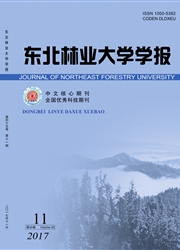

 中文摘要:
中文摘要:
以克隆植物结缕草为研究对象,采用^15N作为示踪元素(从3个不同生长发育阶段复合节的根系引入)。研究了温室环境条件下高(2.5mmol·L^-1)、低(1.0mmol·L^-1)两种浓度的^15NH4^+和^15NO3^-引入后^15N在主匍匐茎内的传输特征。结果表明^15NH4^+和^15NO3^-在引入复合节的叶、根和匍匐茎中δ^15N值一般最高,然后以线性递减趋势进行双向运输,但以向顶运输为主。^15N从基部和中部复合节引入后在主匍匐茎内的传输递减速率前者大于后者,而从梢端复合节引入^15N后,顶端复合节作为“强汇”比较老复合节截获^15N能力更强。根系在引入高、低浓度的^15NO3^-和^15NH4^+时,^15N传输格局有所不同,引入高浓度^15NO3^-和^15NH4^+时,植株倾向于将较多的^15N分配给匍匐茎进行远距离传输,引入低浓度^15NO3^-和^15NH4^+时,则倾向于将较多的^15N分配给引入位点的A、B分株,优先满足该位点分株生长的需要。结缕草主匍匐茎中^15NO3^-和^15NH4^+传输特征总体趋势相似,但其对^15NH4^+营养表现出一定的偏好性。
 英文摘要:
英文摘要:
Based on the ^15 N tracer method, nitrogen transmission in the primary stolons of the clonal plant Zoysia japonica was studied in a greenhouse. Two types of concentrations of ^15NH4^+ and ^15NO3^- solutions were introduced into the multiple-node roots at different growing stages. Result showed that δ^15N values in the leaves, roots and stolons of the multiple-node at the feeding sites were usually the highest, and then decreased linearly towards both basal and distal directions with the liner as the dominance. When ^15N was introduced from the basal multiple-node, the decrease rate of δ^15N in the primary stolons was higher than those from the middle multiple-node. When ^15N was introduced from the distal multiple-node roots, the multiple-node at apex as "strong sinks" acquired more ^15N than elder multiple-node. When two types of eoncentrations of ^15N were introduced into the multiple-node roots respectively, the corresponding transloeation patterns in the primary stolons were different. When higher concentrations of ^15N were introduced, 15N tended to be transloeated farther in the primary stolons, but when lower concentrations of ^15N were introduced, ^15N tended to be translocated to the leaves of the multipie-node at the feeding sites meeting their growing needs. ^15 NH4^+ and ^15 NO3^- transmission features were generally similar in the primary stolons of Z. japonica, but it showed preference to ^15NH4^+.
 同期刊论文项目
同期刊论文项目
 同项目期刊论文
同项目期刊论文
 Interspecific interactions between Phragmites australis and Spartina alterni?flora along a tidal gra
Interspecific interactions between Phragmites australis and Spartina alterni?flora along a tidal gra nterspecific interactions between Phragmites australis and Spartinaalterniflflora along a tidal grad
nterspecific interactions between Phragmites australis and Spartinaalterniflflora along a tidal grad Improvement of hydrogen yield of lba-transgenic Chlamydomonasreinhardtii caused by increasing respir
Improvement of hydrogen yield of lba-transgenic Chlamydomonasreinhardtii caused by increasing respir 期刊信息
期刊信息
